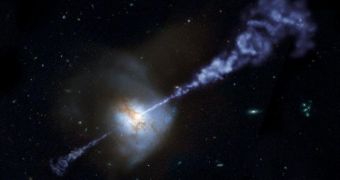Experts with the European Space Agency (ESA) say that the their Herschel Space Observatory has recently been used to demonstrate that the most active supermassive black holes at the cores of galaxies tend to impair stellar formation within the structures they occupy.
This discovery may highlight an interaction and feedback mechanism between the black hole and its host galaxy. Such phenomena are known to exist, but past studies have yielded contradictory results about how they work.
Herschel – the most advanced and complex infrared telescope ever built – has now demonstrated that the mass and feeding habits of galactic black holes are correlated to the amounts of new stars that can form within the cosmic structure.
The finding has significant implications for understanding how the Universe evolved to its current configuration. According to the team behind the new study, the development of supermassive black holes may have begun hindering the formation of new stars when the Cosmos was half its current age.
“We want to know how star formation and black hole activity are linked. The two processes increase together up to a point, but the most energetic black holes appear to turn off star formation,” astronomer Mathew Page explains.
The expert is based at the University College London (UCL) Mullard Space Science Laboratory, in the United Kingdom. He was also the lead author of a new paper detailing the Herschel study, which appears in this week's issue of the top scientific journal Nature.
“Now that we see the relationship between active supermassive black holes and star formation, we want to know more about how this process works,” says NASA Headquarters Herschel program scientist, Bill Danchi.
“Does star formation get disrupted from the beginning with the formation of the brightest galaxies of this type, or do all active black holes eventually shut off star formation, and energetic ones do this more quickly than less active ones?” he adds.
Supermassive black holes are now known to reside at the core of all medium or large galaxies. They can grow to weigh up to several billion times the mass of the Sun, exerting a massive gravitational pull on their surroundings.
However, this force also heats up and disperses the cold hydrogen gas that is absolutely necessary for the formation of new stars. Herschel data indicates that not enough gas can accumulate inside molecular clouds to allow for their collapse into new stars.
Between 8 and 12 billion years ago, the team believes, galaxies were producing new stars at about 10 times the current rate. Most large galaxies were up to 1,000 times brighter than the Milky Way. With the development of supermassive black holes, all these rates and figures decreased considerably.

 14 DAY TRIAL //
14 DAY TRIAL //